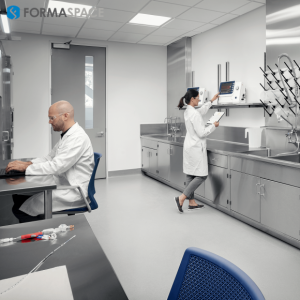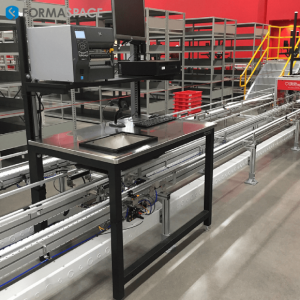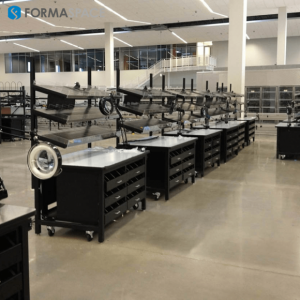Scaling Up Covid-19 Vaccines — from Laboratory R&D to High-Volume Production

Formaspace can build custom lab installations for your most challenging projects. Shown above is a 24-foot-long seamless stainless steel casework installation we manufactured for a sample processing lab.
Take a look at the extraordinary efforts research labs and pharma production facilities are making to create an effective Covid-19 vaccine.
Yet there are reasons to be optimistic. According to Larry Brilliant, a veteran of the war on smallpox, we have not only made great strides in our understanding of how Covid-19 disease affects the body (pathophysiology) but also progress in developing a cure. Brilliant notes that around the world, laboratory researchers are developing “around 160 vaccines today in various stages of trial or hypothesis or funding, with maybe a dozen candidates emerging.”
But finding an effective vaccine is only part of the problem.
The Challenge Of Scaling Up From R&D Into Production
As we have seen with past campaigns that were successful in vaccinating people against terrible diseases (such as polio or smallpox), it’s a massive undertaking to scale up production from the relatively small quantities of active vaccine compounds created in the R&D lab to levels of mass production required to support a world-wide public health vaccination campaign that could potentially inoculate hundreds of millions (if not billions) of people.
The story of penicillin is very instructive.
In the early days of World War II, scientists realized that penicillin (first discovered by the Scottish biologist Alexander Fleming in 1928) was potentially significantly more effective against infection than the widely used sulfa drugs at the time — and if it could be used by soldiers, it could boost the war effort by reducing the level of severe or fatal wartime infections that claimed so many lives in WW I.
Under the threat of bombardment from Germany, Oxford University researcher Howard Florey (an Australian) came to the US looking for assistance in producing the drug. Responding to the call for help, the Rockefeller Foundation in New York engaged Charles Pfizer & Co., Eli Lilly & Co., Merck, and other drug firms to ramp up production.
Yet, as late as 1942, US lab researchers evaluating penicillin had only managed to produce two teaspoons of the drug — when one teaspoon was administered to a test patient, the drug was recovered from her urine to complete dosage treatment.
By 1943, the US War Department made the mass production of penicillin its second-highest priority after the development of nuclear weapons.
The process of cultivating penicillin, which originates in delicate mold spores, proved difficult, as it dissolved away easily. Researchers went out to find stronger strains of naturally occurring penicillin mold sources, and eventually, they created a new deep-tank fermentation production process. Production rates soared, from essentially zero to 100 billion units per month.
Penicillin production benefited from both scaling-up (e.g. creating bigger fermentation vats capable of producing larger quantities of a usable drug) as well as scaling-out (e.g. creating a large number of fermentation tanks to increase production).
Today, scientists and pharma industry production managers are facing similar production challenges, whether it’s scaling up cell therapy manufacturing processes or ensuring that there are enough Covid-19 vaccine doses once an approved vaccine becomes available.
In the case of Covid-19, the actual processes employed to scale up or scale out (or both) will depend entirely on the specific mechanism of the vaccine candidate in question.
If the vaccine candidate is fairly conventional in its approach, it will likely be based on one of three common manufacturing technologies:
Egg-Based Vaccines
Polio and smallpox vaccines are two examples of Egg-Based Vaccines. This process uses chicken eggs to grow the virus, which is then inactivated (a.k.a deadened) before inoculating patients. Downsides to this approach include the inability to safely vaccinate patients who have egg allergies and the need to acquire millions of eggs to scale up the production process.
Cell-Based Vaccines
More recently, the FDA has begun to approve “cell-based” vaccines (such as Flucelvax Quadrivalent for the 2019-2020 flu season), which are grown in the lab from cell cultures. From a manufacturing viewpoint, this has the advantage of not being dependent on egg production.
Recombinant Vaccines
The third approach, recombinant vaccine technology, utilizes an indirect, synthetic process to manufacture vaccine doses without the use of eggs or cell cultures. Scientists first identify a feature of a virus that will trigger a human response, such as the now-infamous antigen “spike” found on Covid-19 viruses.
Scientists then extract the DNA instructions to recreate this specific feature, where it is combined with a virus known to infect invertebrates (e.g. a baculovirus) to create a “recombinant” virus.
The next step in production is to infect specially developed host cells with the recombinant virus to induce them to produce large quantities of antigens, which are then extracted for purification and packaging. (A process known as “finish and fill” in pharma industry jargon.)
RNA And DNA-Based Vaccines
On the other hand, a successful Coronavirus vaccine candidate might be based on one of the newer, leading-edge technologies, such as RNA or DNA-based vaccines. Moderna’s highly touted mRNA-vaccine is one such example; its vaccine candidate carries the mRNA into the body to encourage a human immune system response. These types of vaccines don’t require cell lines — a potential advantage for manufacturing operations — however, they do pose a challenge for regulators, such as the FDA, who have been reluctant to approve any RNA or DNA-based vaccines for human use to date.
The Vaccine Formula Itself Is Only Part Of The Manufacturing Challenge
Vaccination program planners are keenly aware that manufacturing enough vaccine doses is just one battle in the overall war against Coronavirus.
There is an urgent effort underway to ramp up the mass production of vaccine kits to conduct a world-wide vaccination campaign — not just the vaccine doses but the millions of sterile injection needles, wipe pads, and the miniature glass vials to contain the vaccine.
Read more...
Julia Solodovnikova
Formaspace
+1 800-251-1505
email us here
Legal Disclaimer:
EIN Presswire provides this news content "as is" without warranty of any kind. We do not accept any responsibility or liability for the accuracy, content, images, videos, licenses, completeness, legality, or reliability of the information contained in this article. If you have any complaints or copyright issues related to this article, kindly contact the author above.


